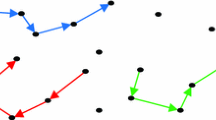Abstract
The concept of a spacecraft for collecting space debris assumes that its orbit continuously changes in relation to the location of space debris in various orbits. The highest density of space debris, which is 10–6 t/km3, is observed at orbital altitudes of 800–1000 and 1400–1500 km with an inclination of 60°–80°. To this end, stable trajectories in the sense of Zhukovskii should be determined. We propose a method for selecting the orbit of a space debris collector, including a robotic spacecraft, using the theorem on the stability of trajectories in the sense of Zhukovskii.




Similar content being viewed by others
REFERENCES
ESA’s Annual Space Environment Report. Esa Unclassified–Releasable to the Public. https://www.sdo.esoc.esa.int/environment_report/Space_Environment_Report_latest.pdf.
Taylor, M.W., Orbital Debris: Technical and Legal Issues and Solutions, Montreal: Institute of Air and Space Law, 2006.
Veniaminov, S.S. and Chervonov, A.M., Kosmicheskii musor - ugroza chelovechestvu (Space Debris–A Threat to Humanity), Moscow: Izd-vo Inst. Kosmich. Issledovanii Ross. Akad. Nauk, 2013.
Adushkin, V.V., Aksenov, O.Yu., Veniaminov, S.S., Kozlov, S.I., and Tyurenkova, V.V., The small orbital debris population and its impact on space activities and ecological safety, Acta Astronaut., 2019, vol. 176, pp. 591–597. https://doi.org/10.1016/j.actaastro.2020.01.015
Mironov, V.V. and Usovik, I.V., Retrospective of the space debris problem. Part 1. Technogenic clogging of space and means of its control, Cosmic Res., 2020, vol. 58, no. 2, pp. 92–104. https://doi.org/10.1134/S0010952520020070
Makarov, Yu.N., Space debris monitoring: Problems and solutions, Nanoindustriya, 2019, vol. 12, no. 1, pp. 6–14. https://doi.org/10.22184/1993-8578.2019.12.1.6.14
Mironov, V.V. and Murtazov, A.K., Retrospective on the problem of space debris. Part 2. Monitoring of space debris of natural origin in near-Earth space using optical methods of meteor astronomy, Cosmic Res., 2021, vol. 59, no. 1, pp. 36–45. https://doi.org/10.1134/S0010952521010056
Osnovy teorii poleta kosmicheskikh apparatov (Fundamentals of Spacecraft Flight Theory), Narimanov, G.S. and Tikhonravov, M.K., Eds., Moscow: Mashinostroenie, 1972.
Barkova, M.E., Zhukov, A.O., Kartsan, I.N., Kuznetsova, V.O., Ulanov, D.V., Kravchenko, I.N., and Khasyanova, D.U., A robotic collector of space debris, J. Mach. Manuf. Reliab., 2023, vol. 52, no. 5, pp. 411–421. https://doi.org/10.3103/s1052618823050035
Khan, M.A., Khan, D.M.Z., Khan, H., Hanzla, M., Jamal, M., Khalid, T., and Ullah, N., Garbage collector robot, Indian J. Sci. Technol., 2020, vol. 13, no. 20, pp. 2065–2070. https://doi.org/10.17485/ijst/v13i20.212
Barkova, M.E., RF Patent 2686415, 2019.
Barkova, M.E., Space vehicle for utilizing space debris in near-Earth space, Tr. Mosk. Aviats. Inst., 2018, no. 103, p. 14.
Druzhinina, O.V., On methods of stability research in the sense of N.E. Zhukovsky for nonlinear dynamical systems, Sistemy upravleniya, tekhnicheskie sistemy. Ustoichivost’, stabilizatsiya, puti i metody issledovaniya. Sb. trudov Mezhdunarodnoi nauchno-prakticheskoi konferentsii, posvyashchennoi 95-letiyu so dnya rozhdeniya professora A.A. Shestakova (Control Systems, Technical Systems. Stability, Stabilization, Ways and Methods of Research: Proc. Int. Sci. and Pract. Conf. Dedicated to the 95th Birthday of Professor A.A. Shestakov), Masina, O.N. and Gladkikh, O.B., Eds., Elets, Lipetsk oblast: Eletskii Gos. Univ. im. I.A. Bunina, 2015, pp. 12–20.
Druzhinina, O.V. and Masina, O.N., Metody analiza ustoichivosti dinamicheskikh sistem intellektnogo upravleniya (Methods of Stability Analysis of Dynamic Systems of Intelligent Control), Moscow: Lenand, 2016.
Yang, X., Liapunov asymptotic stability and Zhukovskij asymptotic stability, Chaos, Solitons Fractals, 1995, vol. 11, no. 13, pp. 1995–1999. https://doi.org/10.1016/s0960-0779(99)00089-2
Seidelmann, P.K., Archinal, B.A., A’hearn, M.F., Conrad, A., Consolmagno, G.J., Hestroffer, D., Hilton, J.L., Krasinsky, G.A., Neumann, G., Oberst, J., Stooke, P., Tedesco, E.F., Tholen, D.J., Thomas, P.C., and Williams, I.P., Report of the IAU/IAG Working Group on cartographic coordinates and rotational elements: 2006, Celestial Mech. Dyn. Astron., 2007, vol. 98, no. 3, pp. 155–180. https://doi.org/10.1007/s10569-007-9072-y
Vepa, R., Dynamics and Control of Autonomous Space Vehicles and Robotics, Cambridge Univ. Press, 2019. https://doi.org/10.1017/9781108525404
Opiela, J.N., Ostrom, C.L., and Marichalar, J.J., Debris Assessment Software (DAS) Reentry Risk Analysis: Mission Planning for Compliance with NASA Standards, 2017.
Opiela, J.N., Hillary, E., Whitlock, D.O., and Hennigan, M., Debris Assessment Software User’s Guide, Lyndon B. Johnson Space Center, 2019.
Klinkrad, H., Space Debris: Models and Risk Analysis, Springer Praxis Books, Berlin: Springer, 2006. https://doi.org/10.1007/3-540-37674-7
Kessler, D.J., Johnson, N.L., Liou, J.-C., and Matney, M.J., The Kessler Syndrome: Implications of Future Space Operations, NASA, 2010.
Jasper, L.E.Z., Seubert, C.R., Schaub, H., Trushkyakov, V., and Yutkin, E., Tethered tug for large low earth orbit debris removal, Advances in the Astronautical Sciences, Charleston, 2012, AAS/AIAA, 2012, pp. 2223–2242.
Pikalov, R.S. and Yudintsev, V.V., Review and selection of large space debris retraction vehicles, Tr. Mosk. Aviats. Inst., 2018, no. 100, p. 2.
Liou, J.-C., Johnson, N.L., Krisko, P.H., Anz-Meador, P.D., et al., The New NASA Orbital Debris Engineering Model ORDEM2000, NASA/TP-2002-210780, S-890, NAS 1.60:210780, NASA, 2002.
Matney, M., An Overview of NASA’s Orbital Debris Engineering Model, Orbital Debris Program Office, Houston, Texas: 2010.
Funding
This article was prepared with financial support from the fund of the President of the Russian Federation (project no. NSh-1357.2022.6 “Models, Methods, and Means for Obtaining and Processing Information about Space Objects in a Wide Spectral Range of Electromagnetic Waves”).
Author information
Authors and Affiliations
Corresponding author
Ethics declarations
The authors of this work declare that they have no conflicts of interest.
Additional information
Translated by M. Shmatikov
Publisher’s Note.
Pleiades Publishing remains neutral with regard to jurisdictional claims in published maps and institutional affiliations.
About this article
Cite this article
Barkova, M.E., Zhukov, A.O., Kartsan, I.N. et al. Designing a Robotic Vehicle for Recycling Space Debris. J. Mach. Manuf. Reliab. 53, 157–163 (2024). https://doi.org/10.1134/S105261882402002X
Received:
Revised:
Accepted:
Published:
Issue Date:
DOI: https://doi.org/10.1134/S105261882402002X




